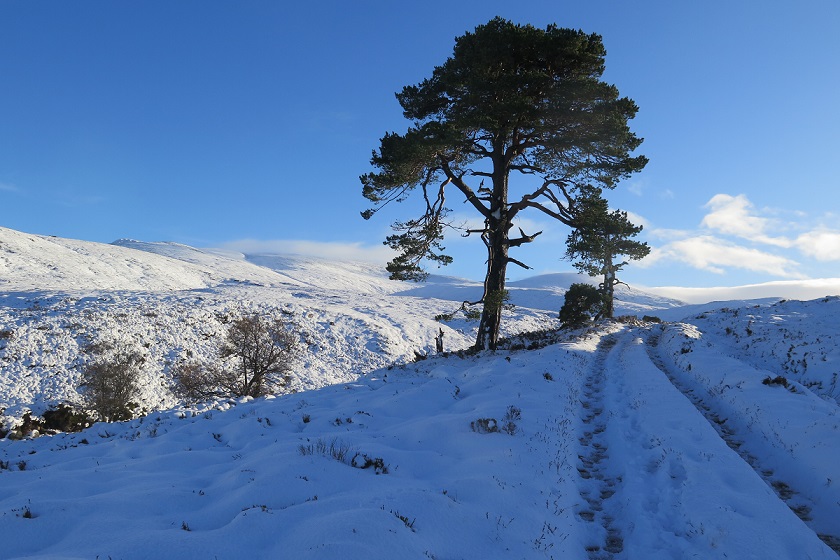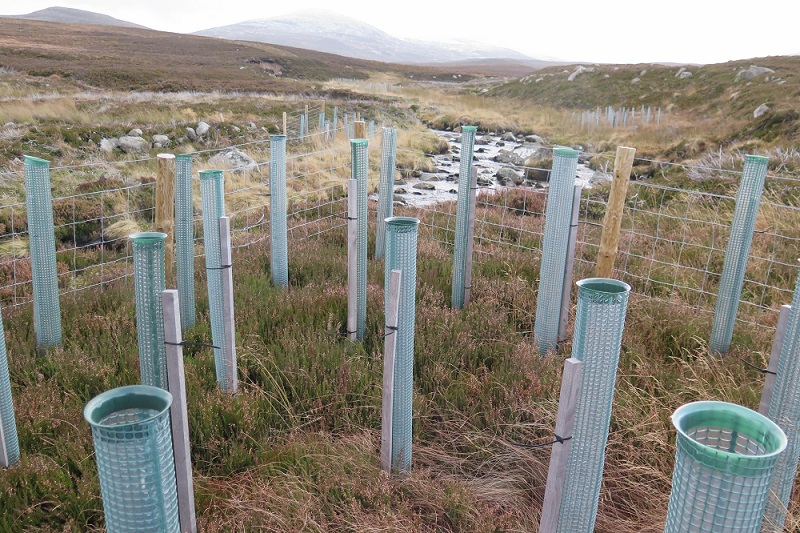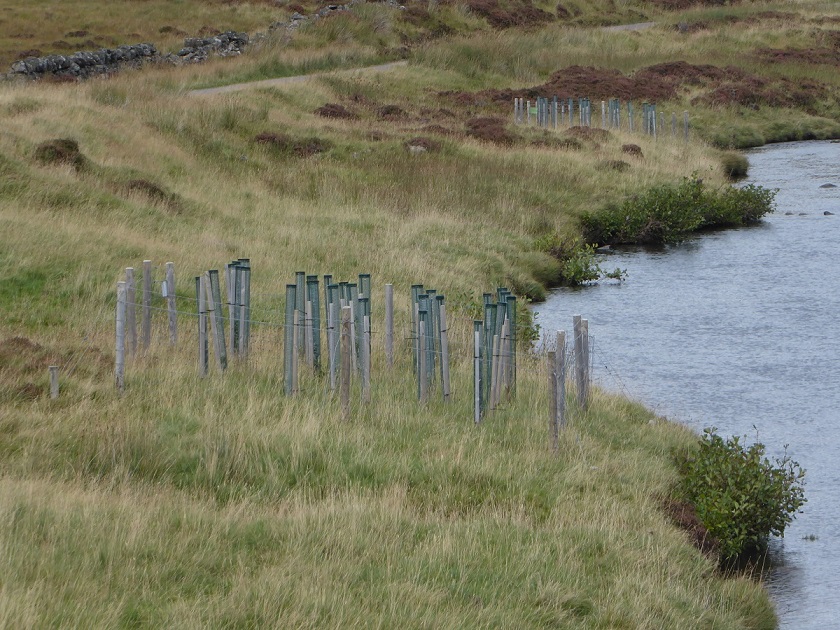
Anyone who wonders why new legislation is needed to regulate deer numbers in Scotland need only study this photograph, taken in Oct 2018, and then read David Lintern’s fine article from 2017 on Walkhighlands “Bare hill of the Hind” (see here).
The Walk Highlands article includes a video of a massive herd of red deer wandering a few miles from Balmoral on the slopes of Creag Leacach, a hill in the ownership of Invercauld and Tulchan estates. These three estates, along with Glen Clova, Glen Isla and Glen Prosen estates form the Executive Steering Group of the South Grampian Deer Management Group (DMG). The video, filmed in December 2016 by Brian Shackleton, current President of Mountaineering Scotland, demonstrates why new legislation is needed to control deer numbers on Balmoral and its fellow estates in this DMG, along with many others across Scotland.
Lintern’s article summarises recent studies on deer issues in Scotland, up to 2017, and provides an excellent explanation of why this is one of the most serious land use issues that needs to be tackled in our uplands.
Today we have a new report, The Management of Wild Deer in Scotland. It was finalised in December 2019 and published by the Scottish Government on 29 Jan 2020 (see here). The report was prepared for the Scottish Government by the Deer Working Group (DWG) which they set up in Oct 2017, under the chairmanship of Simon Pepper, OBE. Simon sadly died in Sept 2018, so the report was completed in the following year by the remaining members of the DWG and their advisers.
It is a very good report within certain limitations. A comprehensive analysis of the history of deer legislation development is provided, alongside a clear explanation of how that legislation has failed to control the expansion of deer numbers in Scotland and failed to protect natural heritage and other public values. It explains how we are trying to manage today’s problems using legislation initially passed by the UK Parliament way back in 1959, adjusted by a new deer Act in 1996 and then subsequently modified a bit in more recent years by the Scottish Parliament. The report makes nearly 100 recommendations for action.
This legislative process was, however, seriously influenced by the landowner interests present within the UK Parliament. This was very evident in the 1990s after agreement had been reached between members of the Red Deer Commission, led by their chairman, Patrick Gordon-Duff-Pennington, and a wide variety of other interests, on how to modify the 1959 Act so that is met modern requirements. Unfortunately, as the subsequent draft legislation made its way through the UK Parliament, it was sabotaged by various landowning members of the House of Lords. They inserted amendments which nullified the ability of the subsequent legislation (the Deer (Scotland) Act 1996) to protect natural heritage values. Some degree of correction then followed in later years through the amendments made by the Scottish Parliament but, as we know today, the present legislation is still far from adequate. The DWG report gives a good explanation of this legislative journey.
This new report also acknowledges the impact of Simon’s tragic death during the course of the DWG’s work. Particular difficulties arose for the remaining authors in delivering on their intention to study how deer are managed on the European mainland and especially the regulatory systems used in other countries and what lessons can be learned for Scotland. The report lacks this information, partly because of the loss of Simon’s expertise and also because of the substantial work burden which fell upon the remaining authors and their advisers in completing other aspects of this comprehensive report. I think the Scottish Government now needs to commission another report, which can be reasonably brief, to explain what happens with deer management and regulation in other countries and how this can inform new deer legislation for Scotland.
A new Act is required – it must be something of an embarrassment to members of the Scottish Parliament to still have a legislative framework for deer in Scotland which is essentially the framework produced by the UK Parliament in 1959 and 1996, all under the weighty influence of the land owning members of the House of Lords. In no way is this fit for modern Scotland, as we see from the damage being done on Balmoral and other estates in the Cairngorms National Park. A new Deer Act should be an essential legislative objective for the next Scottish Parliament, due to be elected in May 2021. The DWG report provides an excellent basis for a new Act, providing it is also informed by a supplementary report which analyses the wider European experience on the regulatory control of deer populations..
Meanwhile I hope the Scottish Government and Parliament examine what legislative tweaks can be achieved, or new policy changes or initiatives taken, during the term of the current Parliament. They have just over a year to demonstrate three things: their understanding of the DWG report; their willingness to take some early, urgent measures in response to the report and, over the longer term, to explain their legislative intentions regarding deer regulation in the next Parliament.
It should not, however, be entirely up to our Scottish Government and Parliament to take action. The other people who should be thinking of good intentions are the landowners. It has taken the arrival in Scotland of a Danish citizen, Anders Povlsen, to demonstrate that, even under the existing legislative framework, private landowners and their staff can protect and restore our natural heritage over thousands of hectares in the Cairngorms, so long as deer numbers are properly controlled. When are Scotland’s home bred private landowners going to learn the lessons from Glenfeshie estate and follow suite?
The DWG report provides a deeply depressing insight into what is going wrong in other parts of the Cairngorms, notably on Balmoral and its neighbours in the South Grampian Deer Management Group. The report highlights the problems associated with deer management by these estates in the Caenlochan area. It recommends this specific area should now be put under investigation by the Scottish Parliament. There has been nearly 20 years of sustained effort by government agencies, first by the Deer Commission for Scotland and then by Scottish Natural Heritage, using successive section 7 “control agreements”, as provided for by the Deer (Scotland) Act 1996, to persuade these landowners to deliver the necessary deer population reductions in the Caenlochan area. The estates have failed in this task. An SNH report to the Scottish Government in Sept 2019 (see here) indicates that the majority of habitats in this area, supposedly protected under the European Union’s Habitats Directive, in recognition of their international importance, are still in an “unfavourable” condition.
Creag Leacach forms the southern spur of Glas Maol, the main summit in the Caenlochan Special Area of Conservation, as recognised by the EU. This is where Brian Shackleton filmed the huge herd of red deer in Dec 2016 (see here). It is not obvious, in 2020, that there has subsequently been any significant reduction in this deer population sufficiently large to secure habitat recovery. Nearly 20 years of voluntary control agreements appear to have achieved nothing.
Meanwhile estates along the River Dee engage in “sticking plaster” conservation – claiming that they are restoring riverine woodland and water quality along the banks of the main rivers through the use of postage stamp fencing, tree guards and planting, while all around thousands of hectares of montane vegetation continues to be overgrazed. Reducing deer numbers overall would be a far more cost effective way of restoring woodland and moorland vegetation along rivers and elsewhere in these upland areas.


A last-resort power to reduce deer numbers to protect the natural heritage is found in section 8 of the Deer (Scotland) Act 1996. It enables SNH to carry out a cull and to re-coup the costs through sale of the venison and charging the landowners with the remainder of the costs. Such a “control scheme” has never been used, presumably because of potential adverse reactions from landowners. The alternative, as indicated above, is “control agreements” set up by SNH under section 7 of the Act. This requires voluntary cooperation by the landowners. But the Caenlochan situation demonstrates that such agreements can go on year after year, involving endless negotiation between SNH and landowners, without any significant habitat improvement, even when these habitats are of international significance. The need to apply a section 8 control scheme to Balmoral and the other 5 estates who lead the South Grampian DMG is obvious.. If the Scottish Government is serious about the climate change emergency and accepts that land use changes are needed now to meet this challenge, it should apply a section 8 control scheme in the Caenlochan area without delay.
Looking further ahead it is evident that a new framework for deer management is needed. That will require the Scottish Parliament to legislate for a Deer (Scotland) Act to replace the previous Acts of 1959 and 1996 as passed by the UK Parliament. The new Act must remove the right of landowners to determine the population levels of all species of deer, recognising that deer are a community resource, not a private possession subject to exploitation. The right to determine the population level of each deer species must be transferred to a local community, regional or national government body so that a publicly accountable organisation determines how many deer are to live within each DMG area.
Meanwhile the Royal Family have been telling the world in recent months how to repair the earth’s life support systems. Excellent, they are doing a good job from Davos to Africa to Pakistan. Now they need to sit down in the nearest castle or palace, read the DWG report, and take the necessary action on Balmoral. While setting this example they also need to provide the essential leadership which is required to persuade their fellow estates in the Cairngorms National Park that overgrazing and degradation of natural forest and montane habitats is totally unacceptable in a time of climate emergency. Regenerating our uplands is an absolute priority to capture carbon, safeguard biodiversity and reduce downstream river flooding. It will also be the perfect legacy for Simon Pepper, who did more than anyone to solve Scotland’s “deer problem”.

Dave, the first picture of the naturally grown trees shows how well they grow and survive in what is quite a hostile environment, but looking at your last two, especially Nick’s, the planting looks far too overcrowded and will presumably therefore end up in stunted growth? I count approximately 30 trees in that small area. The video showing the herd of deer looks more like something out of American plains history! Is there not something odd about that many moving as one herd? It almost suggests that they are heading somewhere with a purpose e.g. are they heading towards a feeding station?
The first picture is taken at the upper fringe of the Ballochbuie Caledonian pinewood on Balmoral estate, looking south towards the lower slopes of Lochnagar. It shows the old forest slowly dying on its feet because deer numbers are too high and prevent any natural regeneration. The forest should be extending across much of the moorland beyond, by natural regeneration, up to the altitudinal limits for tree growth. The postage stamp photos are in watersheds on Balmoral and Invercauld where there are no significant areas of natural forest left. So re-establishment of native forest through planting is OK in such locations but, if deer numbers were under proper control, this could be done through landscape scale planting without the use of tree guards or fencing. This is done elsewhere so why not on Balmoral and Invercauld? Postage stamp planting is an absurd waste of resources which will produce tiny pockets of trees at a time when the climate emergency demands a far more radical approach. All the money going into tree guards and fencing would be far better used to employ more stalkers to cull the deer and to pay for far more native trees to plant in watersheds that lack any remaining native woodland.
Many years (late 90s ?) I watched a similar ‘wave’ of red deer flow across the hillside on the Glen Feshie estate, was difficult to count but must have been a thousand or more deer. At the time the estate feed deer in winter and this was late afternoon so maybe they were heading for a feeding station. I’ve never seen such a large N° of deer before or since
The scale of that riparian planting is pathetic and only aimed at retaining the river banks for fishing!